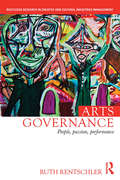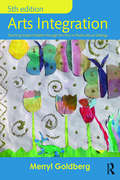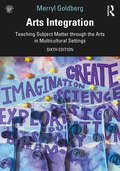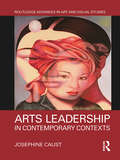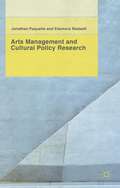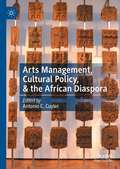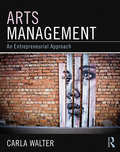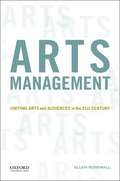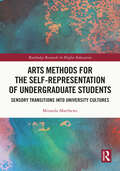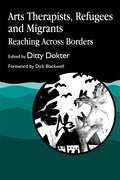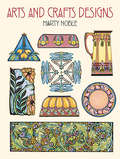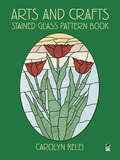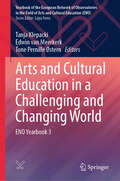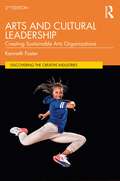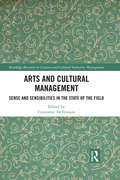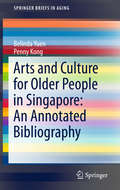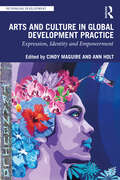- Table View
- List View
Arts Governance: People, Passion, Performance (Routledge Research in Creative and Cultural Industries Management)
by Ruth RentschlerSince the crisis in governance which led to a shortage of capable board members, recent years have seen the emergence of the enterprising arts organisation – a development which has led to the need for new types of board members who have a greater understanding of 'mission, money and merit' within a cultural construct. This innovative book explores the world of the arts board member from the unique perspective of the cultural and creative industries. Using a wide range of research techniques including interviews with board members and stakeholders, board observations and case studies this book provides a rich and deep analysis from inside the boardroom. It provides in-depth insight into the changing pressures on arts boards after the financial crisis, and focuses uniquely on the role of passion on arts boards. Part of the Routledge Research in Creative and Cultural Industries Management series, written specifically for people seeking to develop their careers in cultural and creative management, this book is also for people working in and with arts organisations, in government and non-profit arts organisations. It will also be of interest to academics and researchers working in the wider corporate governance field.
Arts Integration: Teaching Subject Matter through the Arts in Multicultural Settings
by Merryl GoldbergPractical and engaging, Merryl Goldberg’s popular guide to integrating the arts throughout the K-12 curriculum blends contemporary theory with classroom practice. Beyond teaching about the arts as a subject in and of itself, the text explains how teachers may integrate the arts—literary, media, visual, and performing—throughout subject area curriculum and provides a multitude of strategies and examples. Promoting ways to develop children's creativity and critical thinking while also developing communications skills and fostering collaborative opportunities, it looks at assessment and the arts, engaging English Language Learners, and using the arts to teach academic skills. This text is ideal as a primer on arts integration and a foundational support for teaching, learning, and assessment, especially within the context of multicultural and multilingual classrooms. In-depth discussions of the role of arts integration in meeting the goals of Title I programs, including academic achievement, student engagement, school climate and parental involvement, are woven throughout the text, as is the role of the arts in meeting state and federal student achievement standards. Changes in the 5th Edition: New chapter on arts as text, arts integration, and arts education and their place within the context of teaching and learning in multiple subject classrooms in multicultural and multilingual settings; Title I and arts integration (focus on student academic achievement, student engagement, school climate, and parental involvement–the 4 cornerstones of Title I); Attention to the National Core Arts Standards as well as their relationship to other standardized tests and arts integration; more (and more recent) research-based studies integrated throughout; Examples of how to plan arts integrated lessons (using backward design) along with more examples from classrooms’; Updated references, examples, and lesson plans/units; Companion Website: www.routledge.com/cw/goldberg
Arts Integration: Teaching Subject Matter through the Arts in Multicultural Settings
by Merryl GoldbergNow in its sixth edition, Merryl Goldberg’s popular volume Arts Integration presents a comprehensive guide to integrating the arts throughout the K-12 curriculum, blending contemporary theory with classroom practice. Beyond teaching about arts education as a subject in and of itself, the text explains how teachers may integrate the arts—literary, media, visual, and performing—throughout the subject curriculum, offering a wealth of strategies, techniques, and examples. Promoting ways to develop children’s creativity and critical thinking while also developing communications skills and fostering collaboration and community activism, Arts Integration explores assessment and the arts, engaging English Language Learners, and using the arts to teach academic skills in science, math, history, and more. This text is ideal as a primer on arts integration and a foundational support for teaching, learning, and assessment, especially within the context of multicultural and multilingual classrooms. In-depth discussions of the role of arts integration in meeting the goals of Title I programs, including academic achievement, student engagement, school climate, and parental involvement, are woven throughout the text, as is the role of the arts in nurturing Creative Youth Development work and its importance to the community. This revised and updated sixth edition combines a social justice emphasis with templates for developing lesson plans and units, updated coverage on STEAM education, along with brand new examples, case studies, and research. An expanded range of eResources is also available for this edition, including links to further resources readings, additional imagery and videos, and sample lesson plans.
Arts Leadership in Contemporary Contexts (Routledge Advances in Art and Visual Studies)
by Josephine CaustThis book explores and critiques different aspects of arts leadership within contemporary contexts. While this is an exploration of ways arts leadership is understood, interpreted and practiced, it is also an acknowledgement of a changing cultural and economic paradigm. Understanding the broader environment for the arts is therefore part of the leadership imperative. This book examines aspects such as individual versus collective leadership, gender, creativity and the influences of stakeholders and culture. While the book provides a theoretical and critical understanding of arts leadership, it also gives examples of arts leadership in practice.
Arts Leadership: Creating Sustainable Arts Organizations (Mastering Management in the Creative and Cultural Industries)
by Kenneth FosterThe contemporary world faces unprecedented upheaval and change forcing institutions of all types to rethink how they are designed and how they must now function if they are to survive into an uncertain future. The performing arts are no exception; in an era of constant change and technological transformation, arts organizations and their leaders face significant organizational challenges if they are to maintain their relevance. Arts Leadership: Creating Sustainable Arts Organizations provides a contemporary overview of the field of arts leadership, focused on the performing arts. It examines what these challenges are, how they are affecting the performing arts and arts organizations in general and proposes creative ways to reimagine, build and lead sustainable arts organizations in this uncharted environment. With a global perspective drawn from his extensive experience advising arts organizations around the world and based on his own work successfully leading important performing arts organizations in the United States, Foster proposes an innovative approach to organizational design, systems, and structures for arts leaders in the 21st century that is based in ecological thinking and the creative process that is intrinsic to the arts. In disrupting conventional arts leadership practice, the book provides an exceptional tool to understand a unique sector, and is essential reading for students and practitioners across the creative and cultural industries.
Arts Management and Cultural Policy Research
by Jonathan Paquette Eleonora RedaelliPresenting concepts, knowledge and institutional settings of arts management and cultural policy research, this book builds on two assumptions that are simultaneously propositions. The first is that arts management research and cultural policy research evolve in an academic space that is very loosely connected, but nevertheless federated. The second is that we evolve in a field where there is a greater diversity of knowledge producers than it is often assumed. Practicing outside academia, many arts managers, policymakers, advocates, and other professionals still connect and mediate knowledge in spaces that are interconnected, and perhaps even more integrated than we would readily admit. This book offers a map, a representation of the concepts and spaces of knowledge production in the field. It constitutes an excellent introduction to students, and scholars and practitioners will find in it a renewed representation of the field and the seeds of an intellectual debate on our research community.
Arts Management, Cultural Policy, & the African Diaspora
by Antonio C. CuylerThis book centers people of African descent as cultural leaders to challenge the myth that they do not know how or care about managing and preserving their culture. Arts Management, Cultural Policy, & the African Diaspora also presents comparative case studies of the challenges, differences, similarities, and successes in approaches to cultural leadership across multiple cultural contexts throughout the diaspora. This volume disrupts the enduring and systemic global marginalization, oppression, and subjugation that threatens and undermines people of African descent’s cultural contributions to humanity. The most important distinguishing feature of the volume is its geographical use of the African diaspora to explore the subjects of arts management and cultural policy which, to date, no volume has done before. Furthermore, the volume’s comparative examination of ten critical, historical, practical, and theoretical questions makes it a significant contribution to the literatures in Arts Management, Cultural Policy, Cultural, Africana, African American, and Ethnic studies.
Arts Management: An entrepreneurial approach
by Carla WalterArts Management is designed as an upper division undergraduate and graduate level text that covers the principles of arts management. It is the most comprehensive, up to date, and technologically advanced textbook on arts management on the market. While the book does include the background necessary for understanding the global arts marketplace, it assumes that cultural fine arts come to fruition through entrepreneurial processes, and that cultural fine arts organizations have to be entrepreneurial to thrive. Many cases and examples of successful arts organizations from the Unites States and abroad appear in every chapter. A singular strength of Arts Management is the author's skilful use of in-text tools to facilitate reader interest and engagement. These include learning objectives, chapter summaries, discussion questions and exercises, case studies, and numerous examples and cultural spotlights. Online instructor's materials with PowerPoints are available to adopters.
Arts Management: Uniting Arts And Audiences In The 21st Century
by Ellen RosewallDesigned for students and practitioners with little experience in not-for-profit management, Arts Management provides an indispensable guide to the theory and practice of managing arts and cultural organizations. This concise text engages readers with case studies and critical-thinking exercises that will develop their ability to adapt to a changing industry. From governance and human resources to program development, financial management, and marketing, Arts Management addresses the unique atmosphere of managing the arts today. It meets the standards of the AAAE (Association of Arts Administration Educators) guaranteeing that both current and future practitioners will be prepared to meet the challenges of managing today's arts organizations.
Arts Methods for the Self-Representation of Undergraduate Students: Sensory Transitions into University Cultures (Routledge Research in Higher Education)
by Miranda MatthewsThis timely book explores the transitional experiences of undergraduates in minority groups studying at university and how arts methods and practices can play an important role in facilitating these transitions. Based on research from UK universities, this volume is the first to draw together the experiences of educators in the humanities and social sciences who integrate sensory methodologies in taught curriculum, in relation to arts educators who add extra-curricular arts practice. It offers an original, contextualised analysis of how to enable university structures to adapt to complexity, difference, and diversity, taking the view that arts practice forms meeting points for confident interconnection and spaces of self-representation. It outlines the novel concept of sensory transition in how arts practices can be used to address issues of inclusion, diversity, and self-representation for minority groups. Each chapter offers an in-depth analysis of significant issues, such as dimensions of race, gender, and class and the specificities of social and cultural group experiences as they occur in arts practice. The book reflects on the decolonisation of university structures and curriculum and demonstrates how universities can support students and build spaces for self-representation in academic courses. Accessible and investigative, this book is essential reading for academics, researchers, and postgraduate students in the field of higher education, inclusion, and arts methods. It will also be of great interest to higher education staff interested in decolonisation, diversity, and university futures.
Arts Programming for the Anthropocene: Art in Community and Environment (Routledge Environmental Humanities)
by Bill Gilbert Anicca CoxArts Programming for the Anthropocene argues for a role for the arts as an engaged, professional practice in contemporary culture, charting the evolution of arts over the previous half century from a primarily solitary practice involved with its own internal dialogue to one actively seeking a larger discourse. The chapters investigate the origin and evolution of five academic field programs on three continents, mapping developments in field pedagogy in the arts over the past twenty years. Drawing upon the collective experience of artists and academicians in the United States, Australia, and Greece operating in a wide range of social and environmental contexts, it makes the case for the necessity of an update to ensure the real world relevance and applicability of tertiary arts education. Based on thirty years of experimentation in arts pedagogy, including the creation of the Land Arts of the American West (LAAW) program and Art and Ecology discipline at the University of New Mexico, this book is written for arts practitioners, aspiring artists, art educators, and those interested in how the arts can contribute to strengthening cultural resiliency in the face of rapid environmental change.
Arts Therapists, Refugees and Migrants: Reaching Across Borders
by Ditty DokterThe legal and humanitarian response to the world's growing population of refugees and migrants has created more awareness of not only the physical but also the psychological needs of displaced peoples. Refugees are often the forgotten victims of war violence and political upheaval, subjected to the traumatic loss of family and home and the consequent deterioration of cultural identity as they seek asylum in other countries. Ditty Dokter is joined by contributors from a number of multicultural backgrounds, in a volume examining the issues surrounding intercultural arts therapies as a means of working with clients who are refugees and migrants. The role of art, music, dance, and drama in healing the effects of trauma and restoring the sense of cultural and personal identity is discussed, emphasising the need for sensitivity to cultural differences in practice. The ultimate aim is to promote more awareness of intercultural issues in an attempt to build a broader framework for arts therapy practice.
Arts and Crafts Designs (Dover Pictorial Archive)
by Marty NobleInspirational, practical source of 125 superb, royalty-free illustrations for use by graphic artists and designers. Masterfully adapted from textiles, wallpaper, and other authentic sources, the motifs depict florals and insects etched into glassware, garlands of flowers in square and circular configurations, dragonflies adorning decorative bowls and platters, and much more.
Arts and Crafts Stained Glass Pattern Book
by Carolyn ReleiInspired by the elegant simplicity of the Arts and Crafts movement, this compilation of original patterns is the handiwork of an expert in stained glass design. Artists and artisans will find a wealth of design options among its 73 handsome motifs.Here is a garden of florals, with sprays of blossoms and single buds, running patterns of flowering vines, and other images drawn from the natural world, many reduced in the sinuous curved lines that foreshadow the development of Art Nouveau. Framed by oval, rectangular, square, round, and half-round borders, these royalty-free designs are easily adapted for use in a wide variety of craft projects.
Arts and Cultural Education in a Challenging and Changing World: ENO Yearbook 3 (Yearbook of the European Network of Observatories in the Field of Arts and Cultural Education (ENO))
by Tanja Klepacki Edwin Van Meerkerk Tone Pernille ØsternThis book is motivated by questions of how arts and cultural education—like all other fields—are affected by and—together with other fields—can contribute to glocal developments, challenges, and shifts. However difficult the times, arts, and culture in educational contexts have the ambition to make a positive contribution and foster creativity, empathy, and inclusion to encourage critical change, innovation, and peace. But if arts and cultural education remains traditional, unchallenged, and exclusive, those ambitions for critical change towards more inclusive practices that dare to act and make a change in the world, run the risk of remaining utopian rhetoric. It is time for a critical self-examination and willingness to change powers and privileges also within arts and cultural education. Against this background, this book presents brave research on arts and cultural education that offers insight into the conditions, contexts, effects of, and critical changes needed within arts and cultural education. It addresses our time’s great changes, challenges, and possibilities for innovation.
Arts and Cultural Leadership: Creating Sustainable Arts Organizations (Discovering the Creative Industries)
by Kenneth FosterThis textbook provides an expert overview of the challenge of arts and cultural leadership in the contemporary world. Grounded in theories of sustainability and with a renewed global focus for this second edition, the author’s insights from contemporary arts organizations facilitate meaningful student comprehension. Drawing on the work of practitioners and theorists in the fields of philosophy, biology, and ecology as well as the arts, Foster proposes a rethinking of organizational design, strategy, and structure that is based on ecological concepts and the creative process that is intrinsic to the arts rather than the conventional business model that currently prevails, particularly in western arts and culture organizations. He contests conventional thinking about arts administration and management and urges arts leaders to foreground innovation as they reimagine their organizations for a world unlike any other. New sections include an enhanced theoretical discussion as well as new material on business models, strategy, and organizational design and practice. Applicable to any arts organization, the entrepreneurial focus is especially relevant in the aftermath of the global pandemic, the ongoing climate crisis, and the quest for democracy and social justice. This updated edition will be a valuable resource both for present-day arts and cultural leaders who are working to adapt to the current environment as well as students and future leaders who aspire to make change in the world through arts and cultural leadership.
Arts and Cultural Management: Sense and Sensibilities in the State of the Field (Routledge Research in Creative and Cultural Industries Management)
by Constance DeVereauxArts and Cultural Management: Sense and Sensibilities in the State of the Field opens a conversation that is much needed for anyone identifying arts management or cultural management as primary areas of research, teaching, or practice. In the evolution of any field arises the need for scrutiny, reflection, and critique, as well as to display the advancements and diversity in approaches and thinking that contribute to a discipline’s forward progression. While no one volume could encompass all that a discipline is or should be, a representational snapshot serves as a valuable benchmark. This book is addressed to those who operate as researchers, scholars, and practitioners of arts and cultural management. Driven by concerns about quality of life, globalization, development of economies, education of youth, the increasing mobility of cultural groups, and many other significant issues of the twenty-first century, governments and individuals have increasingly turned to arts and culture as means of mitigating or resolving tough policy issues. For their growth, arts and culture sectors depend on people in positions of leadership and management who play a significant role in the creation, production, exhibition, dissemination, interpretation, and evaluation of arts and culture experiences for publics and policies. Less than a century old as a formal field of inquiry, however, arts and cultural management has been in flux since its inception. What is arts and cultural management? remains an open question. A comprehensive literature on the discipline, as an object of study, is still developing. This State of the Discipline offers a benchmark for those interested in the evolution and development of arts and cultural management as a branch of knowledge alongside more established disciplines of research and scholarship.
Arts and Culture for Older People in Singapore: An Annotated Bibliography (SpringerBriefs in Aging)
by Belinda Yuen Penny KongThis book combines in a single volume numerous studies concerning the use of arts and culture to enhance quality of life, health and wellbeing among older people, especially in Singapore. The bibliography covers not only research conducted in Singapore (both published and grey literature), but also a global body of work encompassing the Asia-Pacific region, Europe and North America. In addition to the annotated bibliography, the opening chapter introduces the current state of policy, practice and research on arts and culture for older people in Singapore. The book offers a valuable point of reference for all readers interested in the use of artistic and cultural development as creative and non-pharmacological approaches to providing support throughout the ageing process. It will be particularly useful for anyone interested in research advances in participatory arts therapies and recreational activities for older individuals.
Arts and Culture in Global Development Practice: Expression, Identity and Empowerment (Rethinking Development)
by Cindy Maguire and Ann HoltThis book explores the role that arts and culture can play in supporting global international development. The book argues that arts and culture are fundamental to human development and can bring considerable positive results for helping to empower communities and provide new ways of looking at social transformation. Whilst most literature addresses culture in abstract terms, this book focuses on practice-based, collective, community-focused, sustainability-minded, and capacity-building examples of arts and development. The book draws on case studies from around the world, investigating the different ways practitioners are imagining or defining the role of arts and culture in Belize, Canada, China, Ethiopia, Guatemala, India, Kosovo, Malawi, Mexico, Peru, South Africa, Sri Lanka, Taiwan, Thailand, the USA, and Western Sahara refugee camps in Algeria. The book highlights the importance of situated practice, asking what questions or concerns practitioners have and inviting a dialogic sharing of resources and possibilities across different contexts. Seeking to highlight practices and conversations outside normative frameworks of understanding, this book will be a breath of fresh air to practitioners, policy makers, students, and researchers from across the fields of global development, social work, art therapy, and visual and performing arts education.
